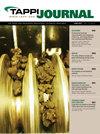Flow characteristics of drag-reducing natural bamboo fiber suspensions with minimal environmental load
IF 0.6
4区 农林科学
Q4 MATERIALS SCIENCE, PAPER & WOOD
引用次数: 1
Abstract
The reduction of pipe friction loss by adding drag-reducing agents has attracted attention as an aid to energy conservation. Drag-reducing agents induce drag reduction (DR) effects and should have a minimal environmental load, with natural resource-saving potential. This study demonstrates bamboo fiber as a drag-reducing agent that saves natural resources and has a low environmental load. Using pressure drop measurements, we report DR with suspensions of bamboo fibers with the average diameter of 13.3 μm and aspect ratio of 98.7. The maximum DR obtained in this experiment is 43% at the concentration of 4000 ppm and pipe diameter of 30 mm; DR is affected by the Reynolds number, suspension concentration, and pipe diameter. In addition, the bamboo fibers can be easily removed from the suspensions by filtration. We found that low-environmental-load bamboo fiber has DR effects like those of other fibers; its effects are greater than those of conventional synthetic fibers and wood pulp. Furthermore, it is resistant to mechanical degradation, recoverable, and recyclable. Therefore, DR effects can be selectively obtained by adding the fibers only when DR is needed; the fibers can then be collected when DR is no longer necessary. This method might greatly expand the application range of DR agents. The results demonstrate the usefulness of bamboo fibers as DR additives.最小环境载荷下天然竹纤维减阻悬浮液的流动特性
通过添加减阻剂来降低管道摩擦损失作为一种节能手段已引起人们的关注。减阻剂具有减阻(DR)效果,应具有最小的环境负荷,具有自然资源节约潜力。本研究证明竹纤维作为一种减阻剂,既节约自然资源,又具有低环境负荷。通过压降测量,我们报告了竹纤维悬浮液的DR,其平均直径为13.3 μm,长径比为98.7。本实验在浓度为4000 ppm、管径为30 mm时,最大DR为43%;DR受雷诺数、悬浮液浓度和管径的影响。此外,竹纤维可以很容易地通过过滤从悬浮液中去除。我们发现低环境负荷竹纤维与其他纤维一样具有DR效应;其效果优于传统合成纤维和木浆。此外,它耐机械降解,可回收,可循环利用。因此,只有在需要endr时,才可以选择性地添加纤维来获得DR效果;当DR不再需要时,可以收集纤维。这种方法可以极大地扩展DR agent的应用范围。结果表明竹纤维作为DR添加剂的有效性。
本文章由计算机程序翻译,如有差异,请以英文原文为准。
求助全文
约1分钟内获得全文
求助全文
来源期刊

Tappi Journal
工程技术-材料科学:纸与木材
CiteScore
1.30
自引率
16.70%
发文量
59
审稿时长
6-12 weeks
期刊介绍:
An internationally recognized technical publication for over 60 years, TAPPI Journal (TJ) publishes the latest and most relevant research on the forest products and related industries. A stringent peer-review process and distinguished editorial board of academic and industry experts set TAPPI Journal apart as a reliable source for impactful basic and applied research and technical reviews.
Available at no charge to TAPPI members, each issue of TAPPI Journal features research in pulp, paper, packaging, tissue, nonwovens, converting, bioenergy, nanotechnology or other innovative cellulosic-based products and technologies. Publishing in TAPPI Journal delivers your research to a global audience of colleagues, peers and employers.
 求助内容:
求助内容: 应助结果提醒方式:
应助结果提醒方式:


